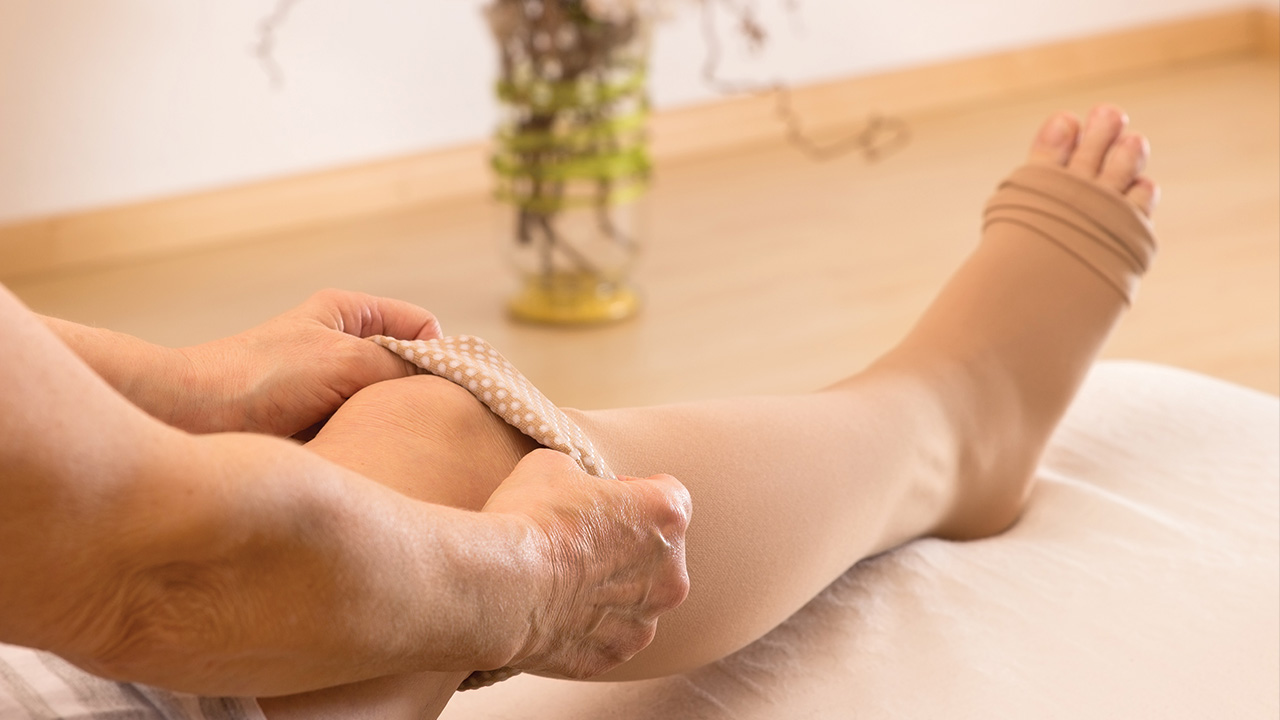For most people, a little weight gain or minor swelling in certain areas of the body might not seem like a reason to seek medical help. However, for older adults and people with chronic medical conditions, these could be signs of edema, an often misunderstood and potentially serious condition.
Once called “dropsy,” edema can be minor or severe, localized or generalized, and can have any number of causes. Edema in elderly individuals is frequently caused by an underlying condition, such as kidney damage, heart failure, chronic lung disease, liver disease or even arthritis. Specifically, the condition occurs when excess fluid leaks out of small blood vessels and is trapped in the surrounding tissues following an injury, surgical procedure, allergic reaction or change in the body’s chemical composition.
Types of Edema
While there are various kinds of edema, the most common is peripheral edema. This occurs in the extremities, producing swollen legs, swollen ankles, swollen feet, and even swelling of the hands and arms.
Generalized edema refers to fluid retention that affects the entire body, but this condition may still appear to primarily affect the extremities due to the force of gravity.
Other types are classified according to the specific organ or system that is affected. For example, pulmonary edema occurs when fluid accumulates in the lungs, lymphedema presents when the lymphatic system is not functioning properly, and corneal edema involves fluid retention in the cornea, affecting vision.
Edema in Old Age
Seniors are typically at a higher risk of edema due to lower activity levels, increased incidence of multiple chronic health conditions, and the amount and types of medications they take. While the above examples are a bit specific, it is important for family caregivers to understand the general symptoms and possible causes of edema to prevent the development of serious complications, some of which can be life-threatening.
Edema Symptoms
Knowing what to look for can be half the battle. General symptoms include:
- Swelling or puffiness of the skin
- Skin that appears stretched, shiny or discolored
- Aching body parts
- Stiff joints
- Weight changes
- Skin that maintains a dimple after being pressed for a few seconds (known as pitting edema)
Causes of Edema in Elderly Individuals
This condition can result from several different contributing health factors. Common causes include physical inactivity, standing or sitting still for too long, hereditary predisposition, surgery, high altitudes, heat, burns, menopause, and excessive salt intake or an unhealthy diet. It often emerges as a result of leaking capillaries which seep fluid into the surrounding tissues, producing swelling.
In rarer cases, low albumin, a protein in the blood that affects how capillaries function, and high blood pressure can both contribute to this. Any obstructions in the body that affect the circulation of fluids like lymph and blood can inhibit drainage and lead to swelling as well. Examples of this include blood clots and tumors. Edema is also a common symptom of heart disease, liver damage and kidney disease.
Certain medications can cause fluid retention, which can be doubly problematic for a patient who is affected by any of the conditions mentioned above. Calcium channel blockers, NSAIDs (ibuprofen, Aspirin, Naproxen, etc.), corticosteroids, and some anti-diabetic drugs can all cause swelling. Prescriptions used to treat Parkinson’s disease and Alzheimer’s disease, such as pramipexole (Mirapex) and memantine (Namenda) respectively, can also cause fluid buildup in the body.
What Happens if Edema Is Left Untreated?
It is important to seek medical attention for edema. If left untreated, it could result in painful swelling, difficulty walking, stiffness, stretched/itchy skin, scarring, poor blood circulation, and reduced elasticity in arteries, veins, and joints. Extreme swelling, often in the feet, ankles and legs, can lead to skin ulcers (wounds), weeping edema and dangerous skin infections like cellulitis. Family caregivers who suspect edema should address the concern immediately with a physician. Some medication changes may be in order to get a loved one’s condition under control.
In some cases, edema can be a symptom of a dangerous underlying condition. Contact a doctor immediately if a senior with a heart or lung condition begins having trouble breathing, having chest pains, coughing and/or feeling fatigued. These may be signs of pulmonary edema, which requires swift treatment.
If a senior is largely sedentary, has recently undergone surgery, or has a blood clotting condition, persistent swelling and pain in one area, typically in the foot or leg, may indicate a blood clot in a deep vein. This condition is called deep vein thrombosis (DVT) and can be fatal if the blood clot travels to the lungs, causing a pulmonary embolism.
How Is Edema Treated?
Of course, treating the underlying cause of a senior’s edema is the primary objective. Managing chronic conditions like heart disease and kidney disease will help minimize swelling and the likelihood of complications. In severe cases, diuretics like furosemide (Lasix) may be used to promote removal of excess fluid through urination. While these medications are effective, they can also upset the balance of important electrolytes (minerals) in the body like sodium, potassium, magnesium, chloride and calcium. A healthy diet and physician supervision are crucial while taking diuretic medications.
How Family Caregivers Can Help Seniors Manage Edema
There are several minor lifestyle adjustments that can have a significant beneficial effect on a patient who is prone to edema. Caregivers should help their loved ones adhere to these guidelines, which can prevent discomfort and serious complications.
Serve Healthy, Low-Sodium Meals
Some foods naturally possess diuretic properties that can help balance fluid buildup, such as asparagus, parsley, beets, grapes, green beans, leafy greens, pineapple, pumpkin, onion, leeks and garlic. Aside from their diuretic effects, these foods are also excellent sources of vitamins, minerals, fiber and antioxidants.
A low-sodium diet is important for maintaining cardiovascular health and minimizing water retention as well. Encourage your loved one to use fresh herbs, citrus, and other sodium-free condiments and seasonings on their food to add flavor instead of reaching for the saltshaker. Be sure to read nutrition labels carefully when purchasing foods as well, since sodium is hiding in everything these days. Keep in mind that current Dietary Guidelines for Americans recommend a daily maximum of 2,300 mg of sodium for adults. While the body needs salt to function properly, a physician or dietician can help you and your loved one devise a balanced and nutritious low-sodium diet that will combat swelling.
Assist With Compression Therapy
If your loved one has a specific limb or area that is affected by edema, it could be beneficial for them to wear a compression stocking, sleeve or glove. Placing added pressure on the area during the day can prevent fluid from collecting there. These products come in a range of compression levels and it is important to work with a physician to make sure the product fits properly and provides the right amount of pressure.
These garments can be difficult to put on and take time to get used to, but they should never be painful or uncomfortable. Work with your loved one’s doctor to learn how to help put compression socks or other items on someone else, or look for products like compression stocking aids to make the process easier. Original Medicare does not cover compression socks in most cases, even if a doctor prescribes them, but some Medicare Advantage plans may offer coverage.
Carefully Consider Massage Therapy
Targeted application of pressure through massage can help circulate excess fluid that has pooled in the extremities. A method known as manual lymphatic drainage can be helpful for individuals who suffer from lymphedema. Be sure to consult a doctor before seeing a licensed medical massage therapist.
Individuals who have high blood pressure, deep vein thrombosis (DVT) or are prone to blood clots should take extreme caution when considering massage. Pressure incurred during a session could potentially loosen plaque from the artery walls and release blood clots that could end up in the heart, lungs or brain. Seniors with fragile or thin skin are not ideal candidates for massage either.
Ensure Proper Skin Care
Even if your loved one’s edema is under control, it can still cause a great deal of discomfort and affect their skin integrity. Be sure to keep the affected areas clean, dry, well-conditioned, and protected with shoes or clothing to avoid cracking, splitting and injuries. Not only are these injuries painful, but they can also become infected very easily.
Encourage Elevation
Resting with the affected limb(s) above the heart can help prevent pooling and improve circulation. It can be difficult to get a loved one to keep their feet or arms elevated regularly throughout the day, but this is one of the simplest options for managing swelling. Slight elevation may be helpful at night during sleep as well. Depending on the part of the body that needs to be elevated, there are countless products, such as pillows, slings and wedges, that can help support proper positioning and offer comfort.
Get Moving, Keep Moving
Using body parts affected by edema is often difficult, but it may help reduce swelling and eliminate excess fluid. Even the smallest movements and mildest exercise regimen can help get blood and lymph circulating and strengthen the cardiovascular system. If your loved one has any other conditions that prevent them from being active or require special care, check with their physician before beginning a new physical fitness plan. The doctor or a physical therapist may be able to suggest specific exercises to reduce symptoms as well.
Monitor and Limit Fluid Intake
We all know that staying hydrated is an important aspect of our overall health. However, for someone with a chronic health condition that causes edema, less is more. In serious cases, such as pulmonary edema due to severe heart failure or peripheral edema due to advanced kidney disease, a senior’s doctor may prescribe daily liquid limits. Many foods like watermelon, soup, ice cream and gelatin contain a great deal of water and should therefore be factored into your loved one’s limit.
There are a few different techniques for carefully adhering to this restricted diet. One method involves using a container that holds the daily allowance amount for reference. With each serving of liquid that is consumed throughout the day, an equal amount of water is poured into the container. Once it is full, no more liquid should be consumed. Another technique is to determine a set serving size of fluid to consume with each meal (and possibly snacks) throughout the day that adds up to the allowance. Spacing out consumption times can help prevent meeting the limit early in the day and becoming excessively thirsty later on.
By understanding the underlying causes and symptoms of edema, discussing treatment options with a health professional, and encouraging lifestyle changes, family caregivers should be able to keep their loved ones safe and comfortable at home for as long as possible.

